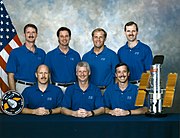STS-82
| STS-82 | |||||
 | |||||
| Uppdrag | 82 | ||||
|---|---|---|---|---|---|
| Rymdfärja | Discovery (22)[1] | ||||
| NSSDC-ID | 1997-004A[2] | ||||
| Färdens tid | 9 dagar, 23 timmar, 38 minuter, 9 sekunder | ||||
| Uppskjutning | |||||
| Startplats | Startplatta 39A vid Kennedy Space Center i Florida | ||||
| Start | 11 februari 1997, 3:55:17 am EST | ||||
| Landning | |||||
| Landningsplats | KSC, Runway 33 | ||||
| Landning | 21 februari 1997, 3:32 am EST | ||||
| Omloppsbana | |||||
| Varv | 149 st[3] | ||||
| Apogeum | 574 km | ||||
| Perigeum | 475 km | ||||
| Banlutning | 28,47° | ||||
| Rymdpromenad | |||||
| Antal | 5 st | ||||
| Total tid | 33 timmar, 11 minuter | ||||
| Besättning | |||||
| Befälhavare | Kenneth D. Bowersox (4) | ||||
| Pilot | Scott J. Horowitz (2) | ||||
| Uppdragsspecialister | Mark C. Lee (4) Steven A. Hawley (4) Gregory J. Harbaugh (4) Steven L. Smith (2) Joseph R. Tanner (2) | ||||
 | |||||
| Kronologi Rymdfärjeprogrammet | |||||
| |||||
STS-82 var en rymdfärjeflygning i det amerikanska rymdprogrammet, den tjugoandra flygningen med Discovery. Den sköts upp från Pad 39A vid Kennedy Space Center i Florida den 11 februari 1997. Efter nästan tio dagar i omloppsbana runt jorden återinträdde rymdfärjan i jordens atmosfär och landade vid Kennedy Space Center.
Uppdraget var att underhålla Rymdteleskopet Hubble.
Väckningar
Under Geminiprogrammet började NASA spela musik för besättningar och sedan Apollo 15 har man varje "morgon" väckt besättningen med ett musikstycke särskilt utvalt antingen för en enskild astronaut eller för de förhållanden som råder.
| Dag | Låt | Artist/Kompositör |
|---|---|---|
| 2 | "Magic Carpet Ride" | Steppenwolf |
| 3 | "These Are Days" | 10,000 Maniacs |
| 4 | "Two Princes" | Spin Doctors |
| 5 | "Higher Love" | Steve Winwood |
| 6 | "The Packerena" | WMYX-FM |
| 7 | "Shiny Happy People" | R.E.M. |
| 8 | "Dreams" | The Cranberries |
| 9 | "That Thing You Do" | The Wonders |
| 10 | "Five Hundred Miles Away From Home" | Reba McEntire |
| 11 | "Born to Be Wild" | Steppenwolf |
Se även
Referenser
- ^ NASA Space Shuttle Launch Archive Arkiverad 29 augusti 2012 hämtat från the Wayback Machine., läst 28 juli 2016.
- ^ ”NASA Space Science Data Coordinated Archive” (på engelska). NASA. https://nssdc.gsfc.nasa.gov/nmc/spacecraft/display.action?id=1997-004A. Läst 22 mars 2020.
- ^ Manned Astronautics - Figures & Facts Arkiverad 4 augusti 2016 hämtat från the Wayback Machine., läst 28 juli 2016.
Externa länkar
 Wikimedia Commons har media som rör STS-82.
Wikimedia Commons har media som rör STS-82.
| ||||||||||||||||||||||||||||||
| ||||||||
| ||||||||||||||||||||||||||||||||
Media som används på denna webbplats
The Hubble Space Telescope as seen from the departing Space Shuttle Atlantis, flying STS-125, HST Servicing Mission 4.
Författare/Upphovsman: Pascal (Flickr user: pasukaru76), Licens: CC0
Vostok spacecraft replica at the Technik Museum Speyer, Germany.
The crew patch for STS-81 , the fifth Shuttle-Mir docking mission, is shaped to represent the Roman numeral V. The Shuttle Atlantis is launching toward a rendezvous with Russia's Mir Space Station, silhouetted in the background. Atlantis and the STS-81 crew spent several days docked to Mir during which time Jerry M. Lineger (NASA-Mir-4) replaced astronaut John Blaha (NASA-Mir-3) as the U.S. crew member onboard Mir. The U.S. and Russian flags are depicted along with the names of the shuttle crew.
The crew assigned to the STS-82 mission included (seated front left to right) Kenneth D. Bowersox, commander; Steven A. Hawley, mission specialist; and Scott J. Horowitz, pilot. On the back row (left to right) are Joseph R. Tanner, mission specialist; Gregory J. Harbaugh, mission specialist; Mark C. Lee, payload commander; and Steven L. Smith, mission specialist. Launched aboard the Space Shuttle Discovery on February 11, 1997 at 3:55:17 am (EST), the STS-82 mission served as the second Hubble Space telescope servicing mission.
STS-82 Mission Insignia
- STS-82 is the second mission to service the Hubble Space Telescope (HST). The central feature of the patch is HST as the crew members will see it through Discovery's overhead windows when the orbiter approaches for rendezvous, retrieval and a subsequent series of spacewalks to perform servicing tasks. The telescope is pointing toward deep space, observing the cosmos. The spiral galaxy symbolizes one of HST's important scientific missions, to accurately determine the cosmic distance scale. To the right of the telescope is a cross-like structure known as a gravitational lens, one of the numerous fundamental discoveries made using HST Imagery. The names of the STS-82 crew members are arranged around the perimeter of the patch with the extravehicular activity's (EVA) participating crew members placed in the upper semicircle and the orbiter crew in the lower one.
The crew patch for NASA's STS-83 mission depicts the Space Shuttle Columbia launching into space for the first Microgravity Sciences Laboratory 1 (MSL-1) mission. MSL-1 investigated materials science, fluid dynamics, biotechnology, and combustion science in the microgravity environment of space, experiments that were conducted in the Spacelab Module in the Space Shuttle Columbia's cargo bay. The center circle symbolizes a free liquid under microgravity conditions representing various fluid and materials science experiments. Symbolic of the combustion experiments is the surrounding starburst of a blue flame burning in space. The 3-lobed shape of the outermost starburst ring traces the dot pattern of a transmission Laue photograph typical of biotechnology experiments. The numerical designation for the mission is shown at bottom center. As a forerunner to missions involving International Space Station (ISS), STS-83 represented the hope that scientific results and knowledge gained during the flight will be applied to solving problems on Earth for the benefit and advancement of humankind.









